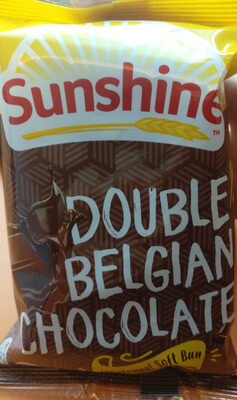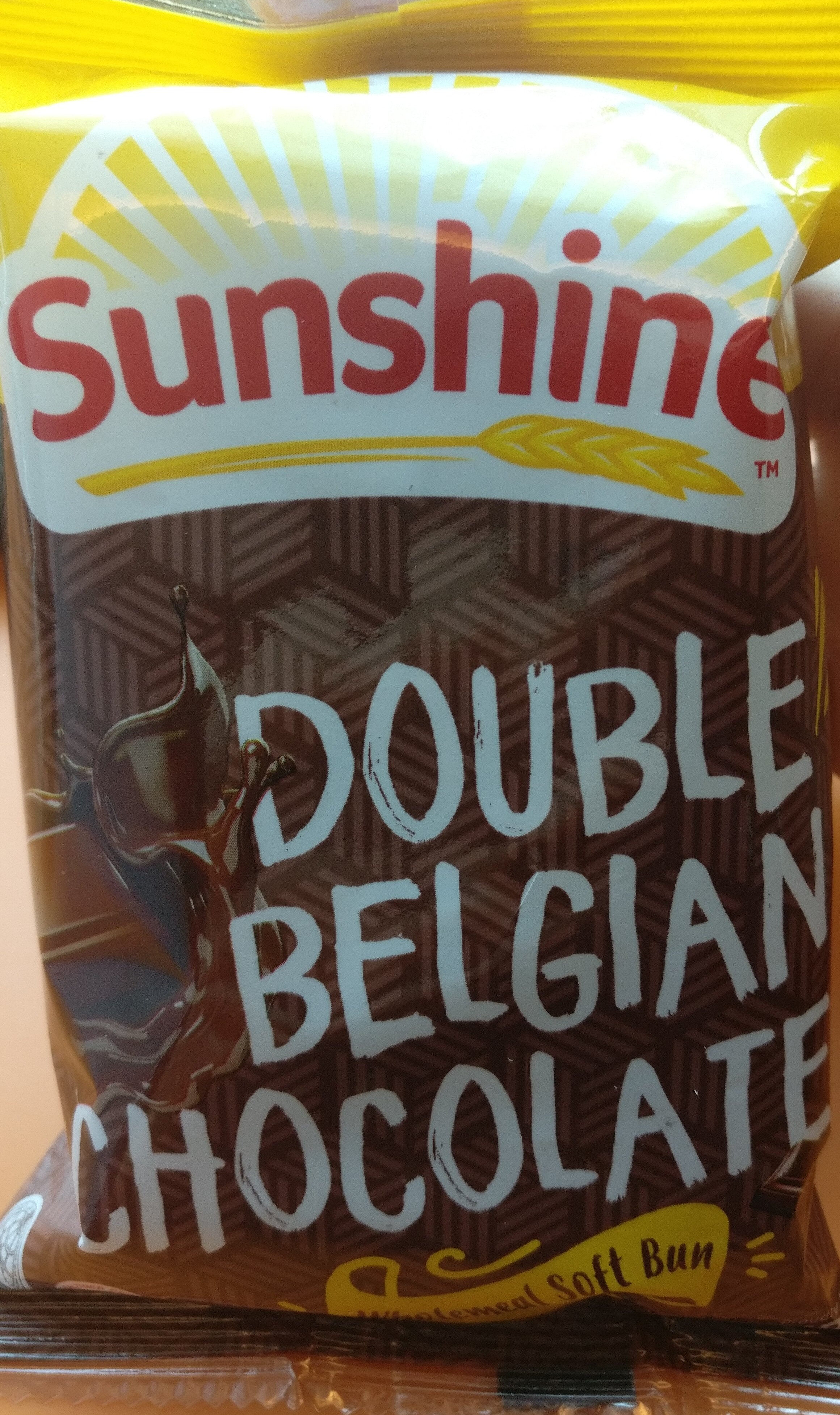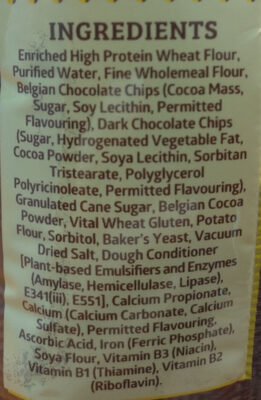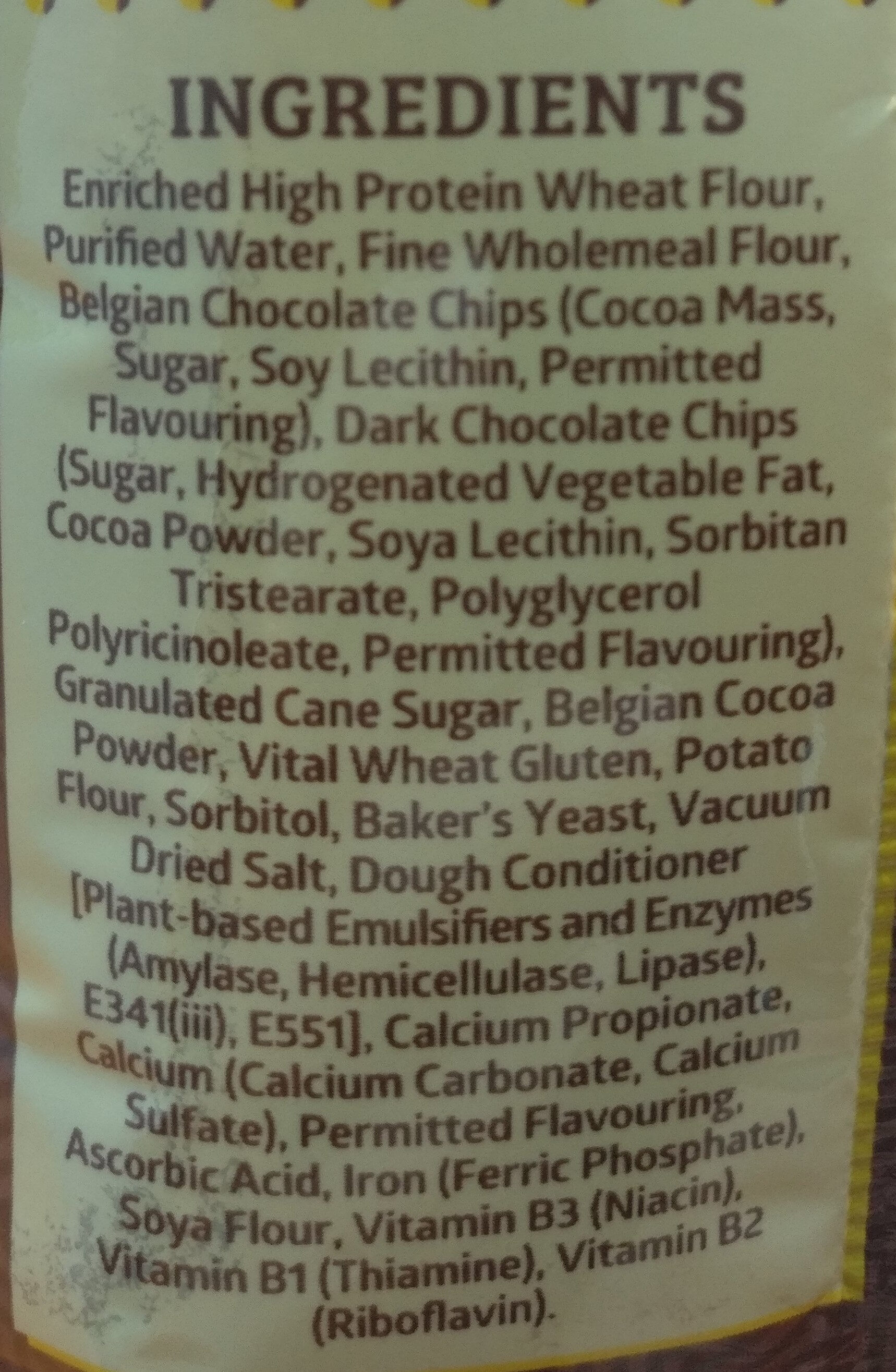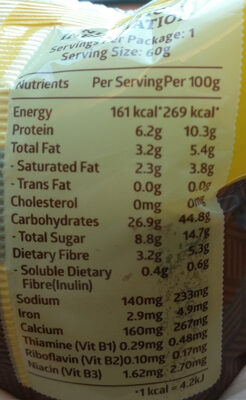Help us make food transparency the norm!
As a non-profit organization, we depend on your donations to continue informing consumers around the world about what they eat.
The food revolution starts with you!
Double Belgian Chocolate - Sunshine - 60 g
Double Belgian Chocolate - Sunshine - 60 g
This product page is not complete. You can help to complete it by editing it and adding more data from the photos we have, or by taking more photos using the app for Android or iPhone/iPad. Thank you!
×
Barcode: 8888010102899 (EAN / EAN-13)
Quantity: 60 g
Packaging: Plastic
Brands: Sunshine
Categories: Snacks, Sweet snacks, Biscuits and cakes, Cakes, Chocolate cakes
Labels, certifications, awards:
Halal, Healthier Choice Singapore
Manufacturing or processing places: Singapore
Stores: 7-Eleven
Countries where sold: Singapore
Matching with your preferences
Health
Ingredients
-
42 ingredients
Enriched High Protein Wheat Flour, Purified Water, Fine Wholemeal Flour, Belgian Chocolate Chips (Cocoa Mass, Sugar, Soy Lecithin, Permitted Flavouring), Dark Chocolate Chips Sugar, Hydrogenated Vegetable Fat, Cocoa Powder, Soya Lecithin, Sorbitan Tristearate, Polyglycerol Polyricinoleate, Permitted Flavouring), Granulated Cane Sugar, Belgian Cocoa Powder, Vital Wheat Gluten, Potato Flour, Sorbitol, Baker's Yeast, Vacuum Dried Salt, Dough Conditioner [Plant-based Emulsifiers and Enzymes Amylase, Hemicellulase, Lipase) E341(iii), E551], Calcium Propionate, Calcium (Calcium Carbonate,Calcium Sulfate), Permitted Flavouring, Ascorbic Acid, Iron (Ferric Phosphate), Soya Flour, Vitamin B3 (Niacin), Vitamin B1 (Thiamine), Vitamin B2 (Riboflavin)Allergens: Soybeans
Food processing
-
Ultra processed foods
Elements that indicate the product is in the 4 - Ultra processed food and drink products group:
- Additive: E322 - Lecithins
- Additive: E420 - Sorbitol
- Additive: E476 - Polyglycerol polyricinoleate
- Additive: E492 - Sorbitan tristearate
- Additive: E551 - Silicon dioxide
- Ingredient: Hydrogenated fat
Food products are classified into 4 groups according to their degree of processing:
- Unprocessed or minimally processed foods
- Processed culinary ingredients
- Processed foods
- Ultra processed foods
The determination of the group is based on the category of the product and on the ingredients it contains.
Additives
-
E1100 - Alpha-Amylase
Amylase: An amylase -- is an enzyme that catalyses the hydrolysis of starch into sugars. Amylase is present in the saliva of humans and some other mammals, where it begins the chemical process of digestion. Foods that contain large amounts of starch but little sugar, such as rice and potatoes, may acquire a slightly sweet taste as they are chewed because amylase degrades some of their starch into sugar. The pancreas and salivary gland make amylase -alpha amylase- to hydrolyse dietary starch into disaccharides and trisaccharides which are converted by other enzymes to glucose to supply the body with energy. Plants and some bacteria also produce amylase. As diastase, amylase was the first enzyme to be discovered and isolated -by Anselme Payen in 1833-. Specific amylase proteins are designated by different Greek letters. All amylases are glycoside hydrolases and act on α-1‚4-glycosidic bonds.Source: Wikipedia
-
E282 - Calcium propionate
Calcium propanoate: Calcium propanoate or calcium propionate has the formula Ca-C2H5COO-2. It is the calcium salt of propanoic acid.Source: Wikipedia
-
E322 - Lecithins
Lecithins are natural compounds commonly used in the food industry as emulsifiers and stabilizers.
Extracted from sources like soybeans and eggs, lecithins consist of phospholipids that enhance the mixing of oil and water, ensuring smooth textures in various products like chocolates, dressings, and baked goods.
They do not present any known health risks.
-
E322i - Lecithin
Lecithins are natural compounds commonly used in the food industry as emulsifiers and stabilizers.
Extracted from sources like soybeans and eggs, lecithins consist of phospholipids that enhance the mixing of oil and water, ensuring smooth textures in various products like chocolates, dressings, and baked goods.
They do not present any known health risks.
-
E341 - Calcium phosphates
Calcium phosphate: Calcium phosphate is a family of materials and minerals containing calcium ions -Ca2+- together with inorganic phosphate anions. Some so-called calcium phosphates contain oxide and hydroxide as well. They are white solids of nutritious value.Source: Wikipedia
-
E341iii - Tricalcium phosphate
Calcium phosphate: Calcium phosphate is a family of materials and minerals containing calcium ions -Ca2+- together with inorganic phosphate anions. Some so-called calcium phosphates contain oxide and hydroxide as well. They are white solids of nutritious value.Source: Wikipedia
-
E420 - Sorbitol
Sorbitol: Sorbitol --, less commonly known as glucitol --, is a sugar alcohol with a sweet taste which the human body metabolizes slowly. It can be obtained by reduction of glucose, which changes the aldehyde group to a hydroxyl group. Most sorbitol is made from corn syrup, but it is also found in nature, for example in apples, pears, peaches, and prunes. It is converted to fructose by sorbitol-6-phosphate 2-dehydrogenase. Sorbitol is an isomer of mannitol, another sugar alcohol; the two differ only in the orientation of the hydroxyl group on carbon 2. While similar, the two sugar alcohols have very different sources in nature, melting points, and uses.Source: Wikipedia
-
E476 - Polyglycerol polyricinoleate
Polyglycerol polyricinoleate: Polyglycerol polyricinoleate -PGPR-, E476, is an emulsifier made from glycerol and fatty acids -usually from castor bean, but also from soybean oil-. In chocolate, compound chocolate and similar coatings, PGPR is mainly used with another substance like lecithin to reduce viscosity. It is used at low levels -below 0.5%-, and works by decreasing the friction between the solid particles -e.g. cacao, sugar, milk- in molten chocolate, reducing the yield stress so that it flows more easily, approaching the behaviour of a Newtonian fluid. It can also be used as an emulsifier in spreads and in salad dressings, or to improve the texture of baked goods. It is made up of a short chain of glycerol molecules connected by ether bonds, with ricinoleic acid side chains connected by ester bonds. PGPR is a yellowish, viscous liquid, and is strongly lipophilic: it is soluble in fats and oils and insoluble in water and ethanol.Source: Wikipedia
-
E492 - Sorbitan tristearate
Sorbitan tristearate: Sorbitan tristearate is a nonionic surfactant. It is variously used as a dispersing agent, emulsifier, and stabilizer, in food and in aerosol sprays. As a food additive, it has the E number E492. Brand names for polysorbates include Alkest, Canarcel, and Span. The consistency of sorbitan tristearate is waxy; its color is light cream to tan.Source: Wikipedia
-
E551 - Silicon dioxide
Silicon dioxide: Silicon dioxide, also known as silica, silicic acid or silicic acid anydride is an oxide of silicon with the chemical formula SiO2, most commonly found in nature as quartz and in various living organisms. In many parts of the world, silica is the major constituent of sand. Silica is one of the most complex and most abundant families of materials, existing as a compound of several minerals and as synthetic product. Notable examples include fused quartz, fumed silica, silica gel, and aerogels. It is used in structural materials, microelectronics -as an electrical insulator-, and as components in the food and pharmaceutical industries. Inhaling finely divided crystalline silica is toxic and can lead to severe inflammation of the lung tissue, silicosis, bronchitis, lung cancer, and systemic autoimmune diseases, such as lupus and rheumatoid arthritis. Uptake of amorphous silicon dioxide, in high doses, leads to non-permanent short-term inflammation, where all effects heal.Source: Wikipedia
Ingredients analysis
-
May contain palm oil
Ingredients that may contain palm oil: Hydrogenated vegetable fat
-
Non-vegan
Non-vegan ingredients: Hydrogenated vegetable fatSome ingredients could not be recognized.
We need your help!
You can help us recognize more ingredients and better analyze the list of ingredients for this product and others:
- Edit this product page to correct spelling mistakes in the ingredients list, and/or to remove ingredients in other languages and sentences that are not related to the ingredients.
- Add new entries, synonyms or translations to our multilingual lists of ingredients, ingredient processing methods, and labels.
If you would like to help, join the #ingredients channel on our Slack discussion space and/or learn about ingredients analysis on our wiki. Thank you!
-
Vegetarian status unknown
Unrecognized ingredients: Enriched-high-protein-wheat-flour, Fine-wholemeal-flour, Permitted-flavouring, Dark-chocolate-chips-sugar, Permitted-flavouring, Belgian-cocoa-powder, Vital-wheat-gluten, Vacuum-dried-salt, Plant-based-emulsifiers-and-enzymes-amylase, Lipase-e341iii, Calcium, Permitted-flavouring, Iron, Ferric orthophosphate, Thiamin, ThiaminSome ingredients could not be recognized.
We need your help!
You can help us recognize more ingredients and better analyze the list of ingredients for this product and others:
- Edit this product page to correct spelling mistakes in the ingredients list, and/or to remove ingredients in other languages and sentences that are not related to the ingredients.
- Add new entries, synonyms or translations to our multilingual lists of ingredients, ingredient processing methods, and labels.
If you would like to help, join the #ingredients channel on our Slack discussion space and/or learn about ingredients analysis on our wiki. Thank you!
-
Details of the analysis of the ingredients
We need your help!
Some ingredients could not be recognized.
We need your help!
You can help us recognize more ingredients and better analyze the list of ingredients for this product and others:
- Edit this product page to correct spelling mistakes in the ingredients list, and/or to remove ingredients in other languages and sentences that are not related to the ingredients.
- Add new entries, synonyms or translations to our multilingual lists of ingredients, ingredient processing methods, and labels.
If you would like to help, join the #ingredients channel on our Slack discussion space and/or learn about ingredients analysis on our wiki. Thank you!
: Enriched High Protein Wheat Flour, Purified Water, Fine Wholemeal Flour, Belgian Chocolate (Cocoa Mass, Sugar, Soy Lecithin, Permitted Flavouring), Dark Chocolate Chips Sugar, Hydrogenated Vegetable Fat, Cocoa Powder, Soya Lecithin, Sorbitan Tristearate, Polyglycerol Polyricinoleate, Permitted Flavouring, Cane Sugar, Belgian Cocoa Powder, Vital Wheat Gluten, Potato Flour, Sorbitol, Baker's Yeast, Vacuum Dried Salt, Dough Conditioner (Plant-based Emulsifiers and Enzymes Amylase, Hemicellulase, Lipase) e341iii, e551), Calcium Propionate, Calcium (Calcium Carbonate, Calcium Sulfate), Permitted Flavouring, Ascorbic Acid, Iron (Ferric Phosphate), Soya Flour, Vitamin B3 (Niacin), Vitamin B1 (Thiamine), Vitamin B2 (Riboflavin)- Enriched High Protein Wheat Flour -> en:enriched-high-protein-wheat-flour - percent_min: 3.57142857142857 - percent_max: 100
- Purified Water -> en:filtered-water - vegan: yes - vegetarian: yes - ciqual_food_code: 18066 - percent_min: 0 - percent_max: 50
- Fine Wholemeal Flour -> en:fine-wholemeal-flour - percent_min: 0 - percent_max: 33.3333333333333
- Belgian Chocolate -> en:belgian-chocolate - vegan: maybe - vegetarian: yes - percent_min: 0 - percent_max: 25
- Cocoa Mass -> en:cocoa-paste - vegan: yes - vegetarian: yes - ciqual_proxy_food_code: 16030 - percent_min: 0 - percent_max: 25
- Sugar -> en:sugar - vegan: yes - vegetarian: yes - ciqual_proxy_food_code: 31016 - percent_min: 0 - percent_max: 12.5
- Soy Lecithin -> en:soya-lecithin - vegan: yes - vegetarian: yes - ciqual_food_code: 42200 - percent_min: 0 - percent_max: 8.33333333333333
- Permitted Flavouring -> en:permitted-flavouring - percent_min: 0 - percent_max: 6.25
- Dark Chocolate Chips Sugar -> en:dark-chocolate-chips-sugar - percent_min: 0 - percent_max: 20
- Hydrogenated Vegetable Fat -> en:hydrogenated-vegetable-fat - vegan: no - vegetarian: maybe - from_palm_oil: maybe - percent_min: 0 - percent_max: 16.6666666666667
- Cocoa Powder -> en:cocoa-powder - vegan: yes - vegetarian: yes - ciqual_food_code: 18100 - percent_min: 0 - percent_max: 14.2857142857143
- Soya Lecithin -> en:soya-lecithin - vegan: yes - vegetarian: yes - ciqual_food_code: 42200 - percent_min: 0 - percent_max: 12.5
- Sorbitan Tristearate -> en:e492 - vegan: maybe - vegetarian: maybe - percent_min: 0 - percent_max: 11.1111111111111
- Polyglycerol Polyricinoleate -> en:e476 - vegan: yes - vegetarian: yes - percent_min: 0 - percent_max: 10
- Permitted Flavouring -> en:permitted-flavouring - percent_min: 0 - percent_max: 9.09090909090909
- Cane Sugar -> en:cane-sugar - vegan: yes - vegetarian: yes - ciqual_proxy_food_code: 31016 - percent_min: 0 - percent_max: 8.33333333333333
- Belgian Cocoa Powder -> en:belgian-cocoa-powder - percent_min: 0 - percent_max: 7.69230769230769
- Vital Wheat Gluten -> en:vital-wheat-gluten - percent_min: 0 - percent_max: 7.14285714285714
- Potato Flour -> en:potato-flour - vegan: yes - vegetarian: yes - ciqual_food_code: 4003 - percent_min: 0 - percent_max: 6.66666666666667
- Sorbitol -> en:e420 - vegan: yes - vegetarian: yes - percent_min: 0 - percent_max: 6.25
- Baker's Yeast -> en:baker-s-yeast - vegan: yes - vegetarian: yes - ciqual_food_code: 11045 - percent_min: 0 - percent_max: 5.88235294117647
- Vacuum Dried Salt -> en:vacuum-dried-salt - percent_min: 0 - percent_max: 5.55555555555556
- Dough Conditioner -> en:flour-treatment-agent - percent_min: 0 - percent_max: 5.26315789473684
- Plant-based Emulsifiers and Enzymes Amylase -> en:plant-based-emulsifiers-and-enzymes-amylase - percent_min: 0 - percent_max: 5.26315789473684
- Hemicellulase -> en:hemicellulase - vegan: maybe - vegetarian: maybe - percent_min: 0 - percent_max: 2.63157894736842
- Lipase) e341iii -> en:lipase-e341iii - percent_min: 0 - percent_max: 1.75438596491228
- e551 -> en:e551 - vegan: yes - vegetarian: yes - percent_min: 0 - percent_max: 1.31578947368421
- Calcium Propionate -> en:e282 - vegan: yes - vegetarian: yes - percent_min: 0 - percent_max: 5
- Calcium -> en:calcium - percent_min: 0 - percent_max: 4.76190476190476
- Calcium Carbonate -> en:e170i - vegan: maybe - vegetarian: maybe - percent_min: 0 - percent_max: 4.76190476190476
- Calcium Sulfate -> en:e516 - vegan: yes - vegetarian: yes - percent_min: 0 - percent_max: 2.38095238095238
- Permitted Flavouring -> en:permitted-flavouring - percent_min: 0 - percent_max: 4.54545454545455
- Ascorbic Acid -> en:e300 - vegan: yes - vegetarian: yes - percent_min: 0 - percent_max: 4.34782608695652
- Iron -> en:iron - percent_min: 0 - percent_max: 4.16666666666667
- Ferric Phosphate -> en:ferric-orthophosphate - percent_min: 0 - percent_max: 4.16666666666667
- Soya Flour -> en:soya-flour - vegan: yes - vegetarian: yes - ciqual_food_code: 20900 - percent_min: 0 - percent_max: 4
- Vitamin B3 -> en:e375 - vegan: maybe - vegetarian: maybe - percent_min: 0 - percent_max: 3.84615384615385
- Niacin -> en:e375 - vegan: maybe - vegetarian: maybe - percent_min: 0 - percent_max: 3.84615384615385
- Vitamin B1 -> en:thiamin - percent_min: 0 - percent_max: 3.7037037037037
- Thiamine -> en:thiamin - percent_min: 0 - percent_max: 3.7037037037037
- Vitamin B2 -> en:e101 - vegan: maybe - vegetarian: yes - percent_min: 0 - percent_max: 3.57142857142857
- Riboflavin -> en:e101 - vegan: maybe - vegetarian: yes - percent_min: 0 - percent_max: 3.57142857142857
Nutrition
-
Average nutritional quality
⚠ ️Warning: the amount of fruits, vegetables and nuts is not specified on the label, it was estimated from the list of ingredients: 0This product is not considered a beverage for the calculation of the Nutri-Score.
Positive points: 5
- Proteins: 5 / 5 (value: 10.3, rounded value: 10.3)
- Fiber: 5 / 5 (value: 5.3, rounded value: 5.3)
- Fruits, vegetables, nuts, and colza/walnut/olive oils: 0 / 5 (value: 0, rounded value: 0)
Negative points: 11
- Energy: 3 / 10 (value: 1125, rounded value: 1125)
- Sugars: 3 / 10 (value: 14.7, rounded value: 14.7)
- Saturated fat: 3 / 10 (value: 3.8, rounded value: 3.8)
- Sodium: 2 / 10 (value: 236.728, rounded value: 236.7)
The points for proteins are not counted because the negative points are greater or equal to 11.
Nutritional score: (11 - 5)
Nutri-Score:
-
Nutrient levels
-
Fat in moderate quantity (5.4%)
What you need to know- A high consumption of fat, especially saturated fats, can raise cholesterol, which increases the risk of heart diseases.
Recommendation: Limit the consumption of fat and saturated fat- Choose products with lower fat and saturated fat content.
-
Saturated fat in moderate quantity (3.8%)
What you need to know- A high consumption of fat, especially saturated fats, can raise cholesterol, which increases the risk of heart diseases.
Recommendation: Limit the consumption of fat and saturated fat- Choose products with lower fat and saturated fat content.
-
Sugars in high quantity (14.7%)
What you need to know- A high consumption of sugar can cause weight gain and tooth decay. It also augments the risk of type 2 diabetes and cardio-vascular diseases.
Recommendation: Limit the consumption of sugar and sugary drinks- Sugary drinks (such as sodas, fruit beverages, and fruit juices and nectars) should be limited as much as possible (no more than 1 glass a day).
- Choose products with lower sugar content and reduce the consumption of products with added sugars.
-
Salt in moderate quantity (0.592%)
What you need to know- A high consumption of salt (or sodium) can cause raised blood pressure, which can increase the risk of heart disease and stroke.
- Many people who have high blood pressure do not know it, as there are often no symptoms.
- Most people consume too much salt (on average 9 to 12 grams per day), around twice the recommended maximum level of intake.
Recommendation: Limit the consumption of salt and salted food- Reduce the quantity of salt used when cooking, and don't salt again at the table.
- Limit the consumption of salty snacks and choose products with lower salt content.
-
-
Nutrition facts
Nutrition facts As sold
for 100 g / 100 mlAs sold
per serving (60g)Compared to: Chocolate cakes Energy 1,125 kj
(269 kcal)675 kj
(161 kcal)-37% Fat 5.4 g 3.24 g -76% Saturated fat 3.8 g 2.28 g -52% Trans fat 0 g 0 g -100% Cholesterol 0 mg 0 mg -100% Carbohydrates 44.8 g 26.9 g -9% Sugars 14.7 g 8.82 g -52% Fiber 5.3 g 3.18 g +85% Proteins 10.3 g 6.18 g +80% Salt 0.592 g 0.355 g +16% Vitamin B1 (Thiamin) 0.48 mg 0.288 mg Vitamin B2 (Riboflavin) 0.17 mg 0.102 mg Vitamin B3/PP (Niacin) 2.7 mg 1.62 mg Calcium 267 mg 160 mg +837% Iron 4.9 mg 2.94 mg +70% Fruits‚ vegetables‚ nuts and rapeseed‚ walnut and olive oils (estimate from ingredients list analysis) 0 % 0 %
Environment
-
Eco-Score D - High environmental impact
⚠ ️Select a country in order to include the full impact of transportation.The Eco-Score is an experimental score that summarizes the environmental impacts of food products.→ The Eco-Score was initially developped for France and it is being extended to other European countries. The Eco-Score formula is subject to change as it is regularly improved to make it more precise and better suited to each country.Life cycle analysis
-
Average impact of products of the same category: C (Score: 47/100)
Category: Chocolate cake
Category: Chocolate cake
- PEF environmental score: 0.60 (the lower the score, the lower the impact)
- including impact on climate change: 7.88 kg CO2 eq/kg of product
Stage Impact Agriculture
48.2 %Processing
45.1 %Packaging
3.2 %Transportation
2.7 %Distribution
0.8 %Consumption
0.0 %
Bonuses and maluses
-
Missing origins of ingredients information
Malus: -5
⚠ ️ The origins of the ingredients of this product are not indicated.
If they are indicated on the packaging, you can modify the product sheet and add them.
If you are the manufacturer of this product, you can send us the information with our free platform for producers.
-
Packaging with a medium impact
Malus: -10
Shape Material Recycling Impact Unknown Plastic High ⚠ ️ The information about the packaging of this product is not sufficiently precise (exact shapes and materials of all components of the packaging).⚠ ️ For a more precise calculation of the Eco-Score, you can modify the product page and add them.
If you are the manufacturer of this product, you can send us the information with our free platform for producers.
Eco-Score for this product
-
Impact for this product: D (Score: 32/100)
Product: Double Belgian Chocolate - Sunshine - 60 g
Life cycle analysis score: 47
Sum of bonuses and maluses: -15
Final score: 32/100
-
Carbon footprint
-
Equal to driving 4.1 km in a petrol car
788 g CO² per 100g of product
The carbon emission figure comes from ADEME's Agribalyse database, for the category: Chocolate cake (Source: ADEME Agribalyse Database)
Stage Impact Agriculture
30.6 %Processing
63.3 %Packaging
3.7 %Transportation
2.2 %Distribution
0.2 %Consumption
0.0 %
Packaging
-
Packaging with a medium impact
-
Packaging parts
(Plastic)
-
Packaging materials
Material % Packaging weight Packaging weight per 100 g of product Plastic
-
Transportation
-
Origins of ingredients
Missing origins of ingredients information
⚠ ️ The origins of the ingredients of this product are not indicated.
If they are indicated on the packaging, you can modify the product sheet and add them.
If you are the manufacturer of this product, you can send us the information with our free platform for producers.Add the origins of ingredients for this product Add the origins of ingredients for this product
Report a problem
-
Incomplete or incorrect information?
Category, labels, ingredients, allergens, nutritional information, photos etc.
If the information does not match the information on the packaging, please complete or correct it. Open Food Facts is a collaborative database, and every contribution is useful for all.
Data sources
Product added on by bcd4e6
Last edit of product page on by packbot.
Product page also edited by openfoodfacts-contributors.
